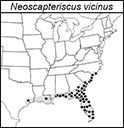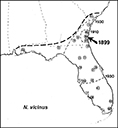|
Alien origin and spread of this SINA species.
|
|
Song at 25°C:
|
A loud, nasal trill at 137 p/s issuing from a horn-shaped opening in the ground during the first 90 minutes after sunset.
|
|
Identification:
|
Tibial dactyls nearly touching at base, separated by less than half basal width of a dactyl. Viewed from rear, sharp lower edge of trochantal blade extending more than two-thirds distance from trochantal tip to junction with femur. Pronotal pattern complex. Forewings longer than pronotum; hindwings longer than abdomen. Length 24-33 mm.
|
|
Similar species:
|
N. borellii and N. abbreviatus have the tibial dactyls well separated at base.
|
|
Habitat:
|
Moist or well-drained, sandy soils in open areas—including fields, lawns, and roadsides.
|
|
Season:
|
One generation per year. Most individuals overwinter as adults, but some overwinter as large nymphs. Eggs are laid in spring. Most calling is Feb.-June, but because adults are long-lived, some calling occurs year-round. Flights occur Feb.-June, Sept.-Dec., but the heaviest flights are in March and April; N. Fla. data.
|
|
Remarks:
|
This destructive insect was first recorded in the United States at Brunswick, Georgia, in 1899. It is native to South America and was perhaps transported in ballast from Buenos Aires or Montevideo. Since 1981 its spread westward along the Gulf coast has continued and its ultimate distribution may include portions of Louisiana and Texas.
Two similar species occur in Puerto Rico, where mole crickets were accidentally introduced and became important pests by l876. N. vicinus was formerly believed to be one of the Puerto Rican species and was misleadingly called the "Puerto Rican mole cricket" or "changa," the latter name being a vernacular Puerto Rican term for mole cricket.
|
|
More information:
|
Family Gryllotalpidae, genus Neoscapteriscus.
|
|
References:
|
Castner & Nation 1986, Hayslip 1943, see additional references on genus page.
|
|
Nomenclature:
|
OSF (Orthoptera Species File Online).
|















